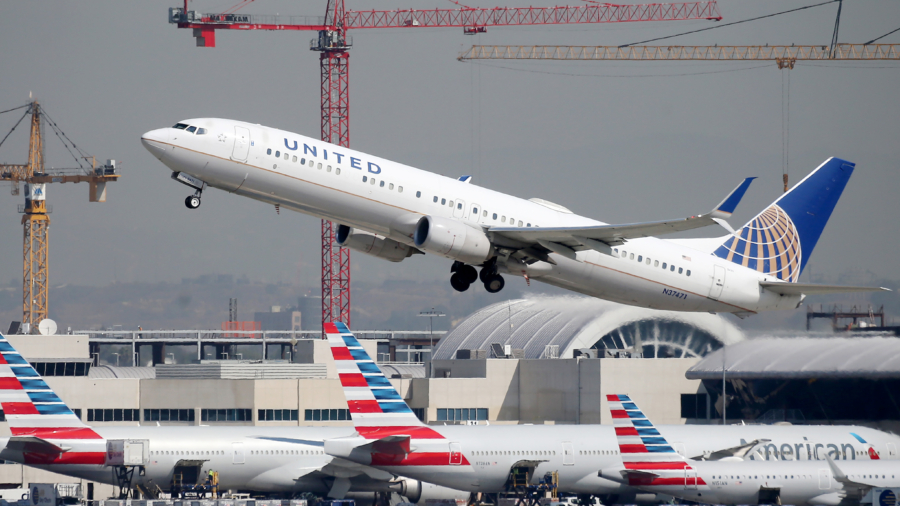Two airliners came dangerously close to colliding at a Sarasota, Florida, runway last month, a preliminary report from the U.S. National Transportation Safety Board (NTSB) shows.
The incident took place on Feb. 16 at around 20:59 p.m. local time and involved a Boeing 737 and an Airbus 321.
Air traffic control cleared an Air Canada Rouge plane—referred to in the report as ROU1633—to take off on runway 14 at Sarasota-Bradenton International Airport (SRQ) at the same time that the incoming American Airlines flight—referred to in the report as AAL2172—was cleared to land and was just over three miles away, according to the report.
“NTSB examination of SRQ radar data revealed that AAL2172 was about ten miles north of SRQ on a visual approach for runway 14 when communications were established with the FAA local controller (LC),” the report said. “The LC then cleared AAL2172 to land on Runway 14. When AAL2172 was on a 3.12-mile final, the LC asked ROU1633 if they were ready for departure, and ROU1633 responded affirmatively.”
Controllers advised each aircraft of the other, according to the NTSB.
“The LC then cleared ROU1633 for takeoff on Runway 14, with instructions to fly the runway heading, and issued ROU1633 a traffic advisory informing them that AAL2172 was on a 3-mile final. About 13 seconds later, when AAL2172 was on a 2.56-mile final, the LC issued AAL2172 a traffic advisory informing AAL2172 that ROU1633 was departing runway 14,” the report said.
Airliners Came Within Seconds of Each Other
“When AAL2172 was on a 1.53-mile final, ROU1633 asked the LC to confirm the departing heading, to which the LC affirmed that ROU1633 was to fly the runway heading. About 53 seconds later, AAL2172 informed the controller they were executing a pilot-initiated go-around.”
A go-around occurs when the pilot aborts a landing.
The NTSB said the two airliners ultimately came within 0.6 miles of each other.
“The estimated closest proximity between ROU1633 and AAL2172 was 0.6 miles horizontally and the same altitude; ROU1633 was departing runway 14 and climbing through 100 feet, and AAL2172 was about 100 feet, and crossing over the runway 14 numbers,” NTSB said.
There were 194 people aboard the Air Canada Rouge aircraft and 178 aboard the American plane, according to the report. None of the passengers or flight attendants on board either of the aircraft were injured, NTSB said.
The agency has formed an air traffic control to investigate the incident and the Federal Aviation Administration (FAA) and the National Air Traffic Controllers Association (NATCA) are also probing the incident.
February’s incident is among a number to occur so far this year, including a near-miss of two aircraft at Boston’s Logan International Airport in the same month, and others in Austin, Honolulu, New York City, and Burbank, California.
Concern Over Near-Misses
The NTSB is currently investigating six incidents in total but a common cause of the incidents has not yet been established.
During an emergency safety summit on Wednesday, NTSB Chair Jennifer Homendy told government and industry leaders that the recent incidents “must serve as a wake-up call for every single one of us, before something more catastrophic occurs. Before lives are lost.”
Elsewhere during Wednesday’s summit, Secretary of Transportation Pete Buttigieg said officials are “particularly concerned because we have seen an uptick in serious close calls,” in recent months.
Although a clear cause of the incidents has not yet been established, some experts believe that increased demand for travel following the removal of restrictions put in place during the COVID-19 pandemic and an influx of new pilots could be placing extra pressure on the aviation industry and systems.
Laura Einsetler, a commercial airline pilot with over 30 years of flying experience, told the BBC: “What we’re seeing now, over the past year, is this really fast ramp-up of air travel and we’re trying to quickly replace that loss of 20–25 percent of our workers [during the pandemic] by hiring people and trying to get them up to speed right now.”
“The pressure is always there to get as many of us in and out of the airports as possible,” Einsetler added. “We need to slow down and be situationally aware.”
From The Epoch Times

